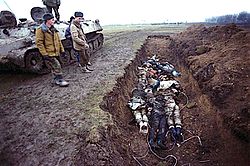Summary
In a March 2001 report, [4] Human Rights Watch (HRW) has documented eight unmarked graves in Chechnya, all of which were discovered in 2000 and 2001; HRW has also documented eight cases in which dead bodies were simply dumped by roadsides, on hospital grounds or elsewhere. The Memorial Human Rights Center also has documented numerous cases. The majority of the bodies showed close-range bullet wounds, typical of extrajudicial summary executions, and signs of mutilation (examinations of some of these bodies by doctors have revealed that some of the mutilations were inflicted while the detainees were still alive, [5] indicating that the victims were also severely tortured). On March 29, 2001, the UN High Commissioner for Human Rights (UNHCR), Mary Robinson, called for a thorough investigation of the mass grave sites in Chechnya. In a statement given to the 57th session of the UNHCR, Robinson stated that the mass graves "must be followed up and thoroughly investigated." [6]
In 2003, residents and human rights campaigners alleged that fragments of blown-up bodies were being found all over the war-ruined region. The critics alleged that rather than put a stop to the human rights violations, the military appeared to be doing its best to hide them. [7] Families were reported to be paying ransom to Russian troops for bodies. [8] On March 31, 2003, the Russian government's human rights commissioner Oleg Mironov called on the authorities to open the mass burial sites in Chechnya to identify the bodies and establish the reasons for their deaths, "and then bury them as humans deserve." At the same time, Mironov rejected the proposal by Parliamentary Assembly of the Council of Europe (PACE) to establish an international tribunal to investigate alleged war crimes committed in Chechnya. [9]
On June 16, 2005, the local pro-Russian government announced that there were 52 mass graves in Chechnya. [10] The chairman of the Chechen government committee for civil rights, Nurdi Nukhazhiyev, was quoted by ITAR-TASS news agency as saying that the graves have not been opened, so the total number of dead was difficult to determine. [11] By 2005, AI estimated that up to 5,000 people who had disappeared since 1999, out of the population of roughly one million, were still missing. [12]
As of 2008, exhuming and identifying the bodies in almost 60 identified but unopened mass burial sites remains a problem. European human rights organizations are financing the construction of a laboratory to identify the bodies. [13] It is not unusual for reconstruction crews in Grozny to run across collections of bodies, and some of them have been quietly moved to make room for the rebuilding. [3] According to the pro-Moscow Chechen government, 4,825 people disappeared, without a trace, in the republic from 1994 to July 2008. [7]
This page is based on this
Wikipedia article Text is available under the
CC BY-SA 4.0 license; additional terms may apply.
Images, videos and audio are available under their respective licenses.
